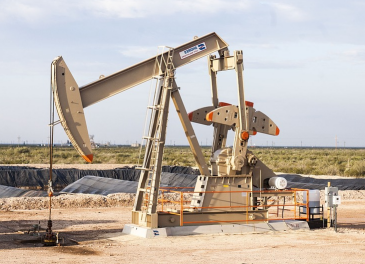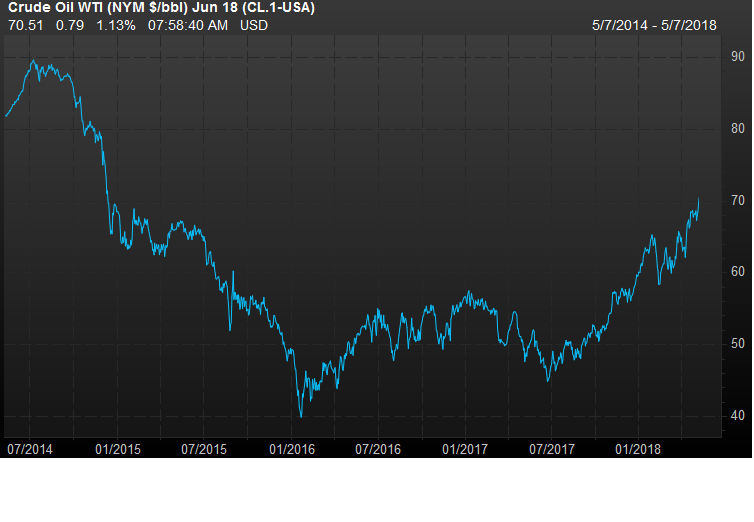Oil prices have surged above $70-here are 4 key reasons behind the rally

- Oil may pull back on 'buy the rumor and sell the fact' response to Iran decision: analyst -
By Myra P. Saefong, MarketWatch
In recent months, oil prices have risen to levels not seen in 3 1/2 years, reflecting a steady, albeit volatile, ascent to a fresh peak, after a global glut of crude sent energy markets into a tailspin in 2014. The recent rally comes amid the possible reinstatement of sanctions on Iran; however, a number of factors have fueled U.S. benchmark oil's march to a perch above $70 a barrel.
The Organization of the Petroleum Exporting Countries' efforts since the start of last year to curb global production have had the biggest influence on crude values, along with growing demand for oil and Venezuela's output woes.
On Monday, West Texas Intermediate crude for June delivery rose $1.01, or about 1.5%, to settle at $70.73 a barrel on the New York Mercantile Exchange, after tapping a high of $70.84. Prices, based on the front-month contracts, haven't reached or settled at levels this high since late November 2014.
Here are at least four key reasons for the resurgence:
1). Opec/non-Opec, crude-oil production curbs
"The number one reason is the OPEC/NON-OPEC accord led by the Saudis and Russians to limit production and lower the exceptionally-high petroleum stocks at the time of the agreement," said James Williams, energy economist at WTRG Economics.
Under the deal, which was implemented at the start of 2017 and runs through the end of this year, OPEC and other major oil producers, including Russia, agreed to cut crude production by roughly 1.8 million barrels a day from late 2016 levels in an effort to eliminate a longstanding glut of global supplies.
An OPEC survey conducted by S&P Global Platts revealed Friday that OPEC's crude production in April fell for a third straight month to a one-year low. It produced 32 million barrels a day last month, down 140,000 barrels a day from March. That is about 730,000 barrels a day below OPEC's ceiling of about 32.73 million barrels a day, when every country's quota under its production cut agreement is tallied, according to the survey.
2). Demand climbing
A large part of the reason the output curbs have had such a sizable impact on global inventories has been growing demand for oil.
Higher economic growth has led to higher oil consumption, said Williams.
The International Energy Agency forecasts global oil demand at 99.3 million barrels a day this year, up from 97.8 million barrels a day in 2017. In a monthly report issued in April, however, the IEA warned that the trade dispute between the U.S. and China could hurt oil demand.
3). Looming reinstatement of Iran sanctions
Still, OPEC member Iran may be the primary reason for the oil's climb, traders say, with the U.S. decision on whether to continue the agreement that lifted economic sanctions on the country in return for Tehran's moves to curb nuclear activity due this Saturday.
President Donald Trump said late Monday afternoon on Twitter that he would announce his decision on the Iran deal Tuesday, four days ahead of the deadline. That prompted a oil-price pullback in electronic trading Monday.
At least one analyst said oil prices could jump by as much as $10 a barrel if sanctions are reintroduced.
Williams, however, said prices are likely to "weaken a little" under that scenario, with a "buy the rumor and sell the fact" response.
Oil prices are likely "near the top, especially if the sanctions are not reinstated," he said, adding that "Iran is already talking about wanting to raise production and Russia is indicating the same."
4). Venezuela woes
Venezuela, meanwhile, has seen big declines in production as it continues to deal with its economic crisis.
S&P Global Platts' OPEC survey issued last week had attributed the fall in April OPEC-member production in large part to "Venezuela's continued output deterioration."
"Venezuela's woes have been well documented, as its barrel count has fallen in every month save three since February 2016," according to Platts survey archives. It produced 1.41 million barrels a day in April, down 80,000 barrels a day from March and marks a 540,000 barrel-a-day plunge from the year-ago level.
S&P Global Platts said Venezuela output was at its lowest in the 30-year history of the Platts OPEC survey, "aside from a 2002-03 strike that severely debilitated Venezuela's state oil company PDVSA."
Williams said the Venezuelan output decline "just helped move the OPEC/NON-OPEC agreement toward their goal a little faster."
But Scott Gecas, senior strategic account executive at Long Leaf Trading Group, said it was "interesting that the Venezuelan news is having such a such an impact on oil price."
"U.S. output is at all-time highs, becoming the number one producer in the world," he said. "Venezuelan output is not that significant I do not expect oil to sustain these levels much longer as global tensions ease."
From MarketWatch

